Leonid Frantsevich, Stanislav Gorb, Vladimir Radchenko,
Dmytro Gladun, Alexey Polilov, Lyubov Cherney, Vassily Browdy,
Maxim Kovalev. 2015. Lehr’s fields of campaniform sensilla in
beetles (Coleoptera): functional morphology. II. Wing reduction
and the sensory field. Arthropod Structure & Development
44, 1-9
Abstract
Loss of the flight ability and wing
reduction has been reported for many taxa of Coleoptera. If elytra
are closed, their roots are clenched between the tergum and the
pleuron, forces applied to the elytra can not be transmitted to
the field of CFS situated on the root. That is why it is plausible
to assume that the field becomes redundant in non-flying beetles.
We examined the relationships between the hind wing reduction
and characters of this mechanosensory field in beetles of six
families. We measured the size of the elytron, that of the hind
wing and counted the number of CFS. Mesopterous non-flying beetles
retain one half to one third of CFS present in macropterous species
of the same body size. Further reduction of the sensory field
in brachypterous species is obvious, but sensilla are still present
in insects with strongly reduced wings, as long as their elytra
are separable and mesothoracic axillaries are present.
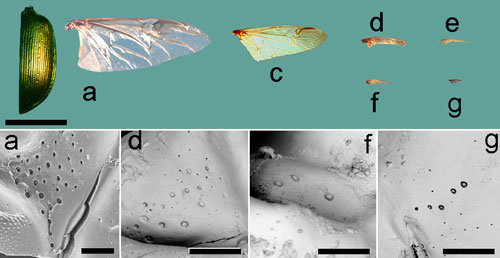
Elytron, wings or wing rudiments (top panel)
and Lehr’s fields on the elytra (bottom panel, SEM) in Calosoma
and Carabus of comparable body and elytral size: (a)
Calosoma sycophanta, (c) Carabus granulatus, (d)
Car. arvensis, (e) Car. cancellatus, (f) Car.
hungaricus, (g) Car. coriaceus. Scale bars 10 mm (top
panel), 50 µm (bottom panel).
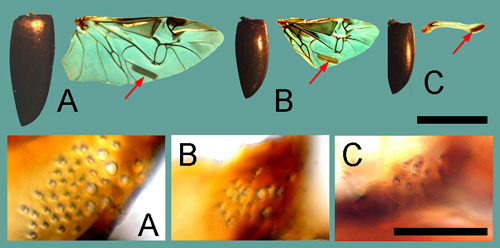
Elytra, wings or wing rudiments and elytral
Lehr’s fields in three diving beetles species formerly included
in one genus Agabus s.l. (Dytiscidae). Top row: elytra
and wings, scale bar 5 mm; bottom row: Lehr’s fields, TLM, scale
bar 50 µm. (A) flying macropterous Gaurodytes bipustulatus
(40 CFS), (B) non-flying mesopterous Eriglenus undulatus
(19 CFS), (C) brachypterous G. bifarius (11 CFS).
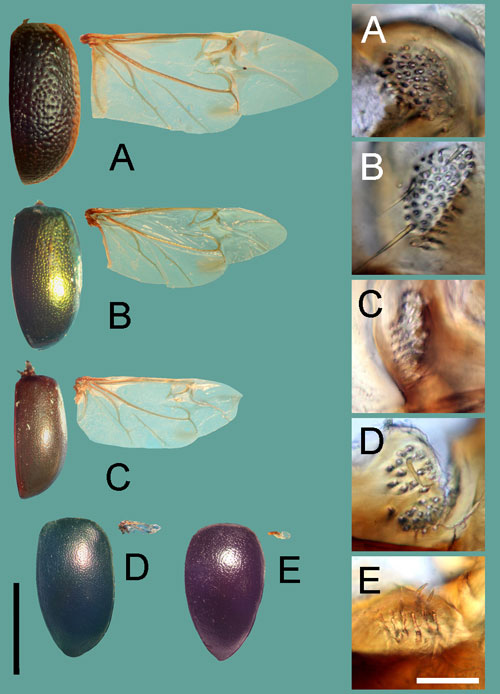
Elytra, wings and elytral Lehr’s fields in macro-,
meso- and brachypterous leaf beetles of the genus Chrysolina.
(A) Ch. gypsophylae, 47 CFS; (B) Ch. herbacea, 51
CFS + 3 hairs; (C) Ch. polita, 36 CFS; (D) Ch. coerulea,
32 CFS + 1 hair; (E) Ch. olivacea, 7 CFS + 2 hairs. Scale
bars 5 mm for macrophotographs, 50 µm for TLM microphotographs.
Complete loss of CFS coincides with the existence
of the permanent sutural lock.
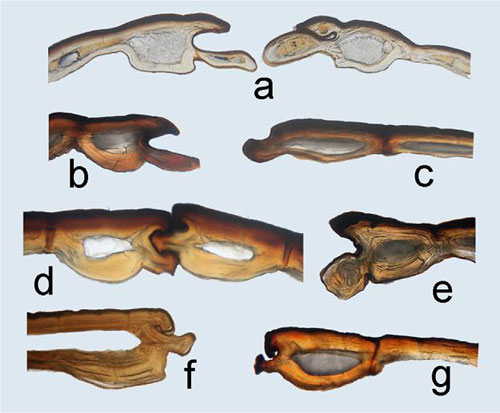
Temporal and permanent sutural locks in non-flying
beetles: cross-sections of sutural ridges. (a) Plug and socket
split pair in macropterous Calosoma inquisitor; (b) split
ridges in brachypterous Carabus cancellatus; (c) split
ridges in brachypterous Liparus glabrirostris; (d) plug
and socket permanent pair in wingless Blaps lethifera;
(e) bulbous permanent plug in macropterous Carabus granulatus;
(f) same in wingless Timarcha tenebricosa; (g) same in
wingless Lethrus apterus.
However, some beetles with permanently locked elytra still retain
few CFS.
A very special case of an extreme wing modification
in feather-wing beetles is considered. No sensilla were revealed
either on the root of the elytron or on the basal segment of such
fringed wings in flying ptiliid species.
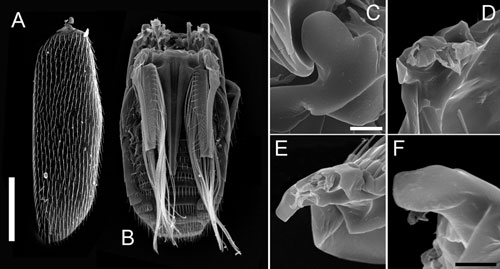
Fore and hind wings in a miniature beetle Primorskiella
anodonta (Ptiliidae). (A) elytron; (B) trunk with folded
pennate wings; (C-F) elytral root in various aspects: dorsal face
(C), ventral face (D), medial face (E), lateral face (F). No pits
or slits were revealed on a smooth surface of the elytral root.
Scale bars 100 µm (A, B), 5 µm (C-E), 5 µm (F).
|
|



